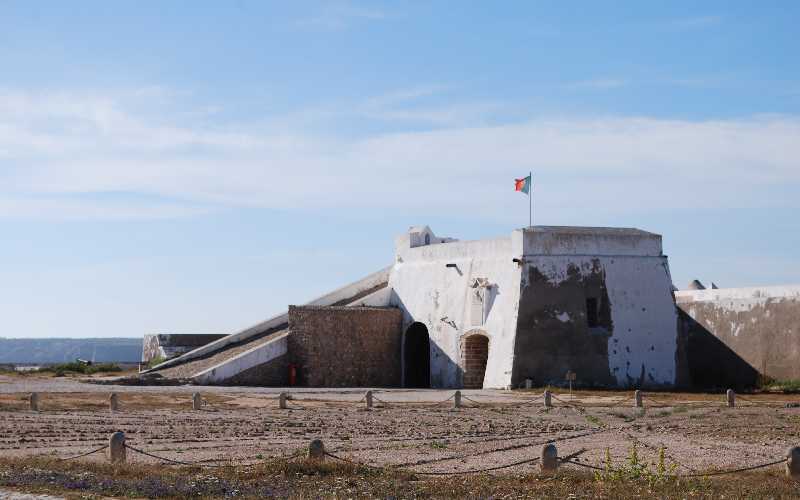Sagres, found at the most western point of the southern Algarve is an area of real natural beauty with ragged cliffs overlooking stunning beaches and the sea below.
Sagres castle or Sagres fort as it is also known by, is situated upon a piece of headland jutting out into the Atlantic Ocean. It is important to the maritime history of Portugal, being a vital part of Portugal’s defence systems during that time. It has been a National Monument since 1910.
Below, I will detail some of this history and give you some facts about what to expect from a visit to Sagres castle:
History and Architecture
The original fort dates back to the 15th century, when the Portuguese coastline was a prime target for pirates from North Africa.
Initially, it was instructed to be built by Henry the Navigator, who is known to have spent a lot of time in Sagres and set off from here on his maritime adventures. He has long been rumoured to have been the first European to discover the African coastline!
The fort was later raided by an English sailor in 1460 and that, coupled with the earthquake and tsunami of 1755 sadly destroyed a lot of the fort.
Today, visitors can see the walls and entrance arch of the main building that would have once stood there. It has become a popular attraction in Sagres. There are several information stands dotted around which provide visitors with valuable information about the history and significance of the fort. These are written in both Portuguese and English.
The views out across the Atlantic Ocean are breathtaking!
While visiting, you can also see the wind compass-rose, which measures in at 43 metres in diameter. Usually compass roses are split into 32 sections, however, this one has 40. This may suggest that this was a mistake during restorations in the 20th century and that this compass doesn’t actually date back to Henry the Navigator’s time. It has been said that the circle was discovered under the earth during the 18th century and excavated in 1919, regardless it’s still interesting to view.
There also, is a small Baroque styled chapel on the site, which can be visited too. This was built around the mid 1500s and features several pictures of Saint Vincent. The chapel is to your right-hand side as you enter the fort.
There are several other interesting elements to be seen, including cannons on your left-hand side as you enter, pointing out over the sea, which make you think about the significance of this site in protecting Portugal from the Moorish pirates advances!
Over the years, some modern facilities have been added, including a new building which houses a shop and cafeteria as well as an interesting exhibition space and multimedia centre!
Getting to Sagres Castle
Public transport can be somewhat limited in Sagres, due to its small size, however, the Lagos-Sagres intercity bus will take you into Sagres itself. From there you would have a 1 km walk, taking you approximately 30 minutes, to reach the castle.
There is some parking available if you choose to travel by car.
There is always the option of getting an Uber or a taxi from Sagres out to the castle. It would only take 5 minutes max and would cost approximately €4.
Accessibility and Costs
Entry to the castle is €3 for adults and half price for children, students and seniors. They do also offer a family ticket which may be a good option for some people.
There’s no need to book tickets in advance, these can be purchased on arrival.
Visiting is available everyday, except the 1st of May, the 22nd of January, Christmas Day and New Years Day. From May to September, the opening hours are 10 am to 8 pm. And from October to April, the opening hours are 10 am to 5.30 pm. Last entry is a half hour before closing, although I’d recommend giving yourself more time!
Accessibility is good and there is access for people with reduced mobility and for wheelchair users.
Once inside there is also the opportunity to use a walking path to go along to Cape St. Vincent and back, which would take you approx 45 minutes. It’s a fantastic way to soak in some more of those amazing sea views and get lost in nature, listening to the waves crashing onto the cliffs below you.
It is a fascinating site, particularly if you are interested in Portugal’s Age of Discovery and the maritime adventures of Henry the Navigator. When there, you can really feel the historical significance.
The information boards found at various locations within the castle are particularly useful and provide further insight. And the coastal views certainly make you stop and take notice!
For any further information you may have on visiting Sagres castle, you can check the following website:
http://www.monumentosdoalgarve.pt/pt/monumentos-do-algarve/fortaleza-de-sagres
Overall, a fascinating site and definitely one worth a visit!
If you enjoyed this article you might also like to read about Western Algarve – Introducing the Region



1 thought on “Sagres Castle”